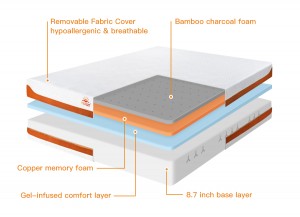New York City, New York Aug 17, 2021 (Issuewire.com) - For over 38 years, Maxzzz has helped people all around the world get more restorative sleep. Mattress by mattress, topper by topper, pillow by pillow, Maxzzz is sharing the joy of good sleep for the greater good. Besides making bedding items, Maxzzz also shares the knowledge to help people choose the right beds.
While choosing a mattress for tranquil comfort, deciding the thickness is an integral part of the process. The thickness of the mattress is directly related to the comfort level, if choosing a poor quality mattress, it will barge in with the comfort zone and lead to poor sleep and sagging. Sleepers should consider the recommended mattress thickness so that they do not have sleeping problems, either not affecting their body shape or sleeping position.
Mattress Thickness Chart
The mattress thickness doesn't only depend upon the standard size, however, it comes with the average thickness choice. Usually, the standard size of a high-quality mattress is around 8 to 14 inches. The different thickness of mattresses suits different people, however, the mattresses with thin layers are not good for consistent use.
Here is how mattresses are grouped based on their thickness:
· Slim mattresses: 5 to 8 inches
· Standard mattresses: 8 to 12 inches
· Tall, thick, and deep mattresses: 12 to 16 inches
· Extra tall, thick, and deep mattresses: more than 16 inches.
While you are making the decision, consider the difference between a low-quality mattress and a slim mattress.
Factors Determining the Thickness of the Mattress
The first and foremost thing that matters while choosing a mattress is the thickness of every layer inside it. High-quality mattresses usually have three or more four layers, which have different materials. These mattresses are created in such a way as to provide maximum support to the sleepers. Let’s take a glance at two important layers that specifically determine the thickness.
Base Layer
The foundation layer or the base layer defines the durability of the mattress, it is usually comprised of latex, poly-foam, or pocket springs. This layer is made up of no less than 50% of your bedding thickness. It is known as the supportive core that reinforces the rest of the mattress. Usually, the mattresses that have a thick base layer are more durable than the ones with thinner layers.
Comfort Layer
It is the upper layer of the mattress, it is the comfy and cushiony layer that gives support to the body curves providing motion, temperature regulation, relief, and isolation. The comfort layers are usually 2 to 3 inches thick to give maximum relaxation.
There are different mattresses types. The mattresses have a pillow uppermost surface which is comprised of soft material, packed and stitched along the cover of the mattress. For example, in the innerspring bed, the comfy layer is an uppermost pillow made of wool, poly-foam, and cotton. Moreover, in the other types of mattresses such as memory foam mattresses, hybrid or latex comprises memory foam or latex comfy layers.
A few beds may just have one relaxing layer, whereas some of the others can have a few to improve the bed's padding. These additional layers might incorporate cooling benefits, drafted support technology, or give an extra leap to your bed.
Deciding the Mattress Thickness
There are certain things to consider while deciding on the right mattress thickness. As the above-mentioned chart, there are different thickness which provides support to the body curve but there is a factor of reliability and durability which is first and foremost.
If you are looking for a durable and high-quality mattress with a pretty definite mattress height, it must be eight inches thick. This is the minimum requirement which includes a 2 to 3-inch thick comfort layer and a base layer that should be 5 to 6 inches thick.
Greater isn't in every case better with regards to mattress thickness. The bedding thickness you need relies upon your height, weight, sleeping position, your versatility, and different other elements.
Your bed should be 25 inches in height so that you can easily sit on the edge of your bed and your feet touch the surface.
The more a mattress is thicker the more it will be softer and comfortable. Here we discuss the important factors to consider while deciding the thickness.
Body Weight
The mattress thickness and the materials utilized make it to decide how your bedding reacts to the weight. You ought to pick bedding steady enough for an agreeable night's rest, and that decision is somewhat dictated by your weight.
· Sleeper weighing less than 130 pounds should get a mattress of 12 inches in height or thicker seems a good choice for people with lightweight.
· Sleeper weighing between 130 to 230 pounds should get a mattress having a thickness between 10 to 12 inches, relying upon the sleeping position it affects how you feel on the mattress.
· Plus size sleepers weighing more than 230 pounds should get a mattress of 12 to 14 inches thick.
Sleeping Position
The sleeping position directly affects how much you are comfortable on the mattress. There are different types of sleeping positions such as stomach sleep, side sleep, combination sleep, and back sleep. Thereby, you should be careful about sensitive body parts. So this is important to choose the thickness that supports your sleep needs.
· For the back sleepers, the mattress should be firm 10 to 12 inches thick. A firm mattress supports the shoulders and buttocks as well as keeps the spine aligned.
· The side sleepers should choose a mattress around 12 to 14 inches thick. The thick comfort layer supports all the widest body parts including hips and shoulders.
· Combination Sleepers should choose a mattress 12 inches thick that gives a medium feel. They keep changing the sleeping positions so the mattress should provide softness and firmness to them.
· Stomach sleepers need firm and thin mattresses that should be around 10 to 12 inches thick. They need comfort and support for their hips and to keep the body in shape.
Health Conditions
Some people have certain medical conditions such as back pain, shoulder pain, arthritis, hip pain, and different body aches. The back pain suffers should get a mattress ranging from 8 to 12 inches thick to provide a firm and good feel. People who have other medical conditions should get a mattress having a thickness range between 12 to 14 inches.
The Height of the Bed
If you have limited portability for reasons unknown, excessively tall or short of a bed can make it hard to get in and out of. In a perfect world, your bed ought to associate with 25 inches off the surface. Along these lines, you can sit on the edge of the bed with your feet contacting the floor and your knees following your hips.
You'll need to consolidate the profundity and the mattress height to guarantee your bed will in any case be open. At the point when your bed is excessively high, it's harder to move all through the bed every evening.
Bed Sharing
Offering another bed to a partner will add more pressing factors to your mattress than if you were resting alone. Squeezing a slim mattress will make it droop and may affect your sleep. In this way, in case you're sharing your bed, it ought to be something like 10-12 inches thick.
FAQ
Is a thicker mattress better?
For enhanced support and comfort it is important to get a thicker mattress which should be 10 inches thick. It depends upon your sleeping position, if you are a side sleeper then you should go for a 12 to 14 inch thicker mattress that gives you extra support, comfy feel, and cushioning you require for the relaxing sleep.
What is the normal depth of a mattress?
The normal depth of a mattress should be 8 to 14 inches. The standard mattress depth is 10 inches. As far as affordability is concerned, the sleeper could find this ideal depth in the popular king and queen mattresses. The best mattresses have a comfort layer of 2 to 3 inches and the base layer of at least 6 to 8 inches. Moreover, mattresses also have a transition layer 1 to 2 inches thick.
Is an 8-inch mattress too thin?
Assuming you need an agreeable and sturdy sleeping mattress, it ought to be somewhere around 8 inches thick, including the base necessity of a 2 to 3-inch thick solace layer and a 5 to the 6-inch thick base layer. Typically, the thicker a sleeping mattress, the milder and softer it feels.
What is the best thickness for a memory foam mattress?
The right offset is best accomplished with a sleeping cushion of 10 inches or more. You can respect the suggested standard mattress thickness for adaptable padding sleeping cushions as 10 and 12 inches. To an average person, memory foam mattresses of 8-inch thickness or below are said to be very thin to give enough comfort and support. The mattresses with an 8-inch structure are not considered to be good enough for adequate comfort. The mattresses are usually made of different layers of memory foam layers usually they are two or more layers. The thicker mattress makes the body feels softer.
Media Contact
Maxzzz gelina@maxzzz.com 86 18938921749 https://www.maxzzz.com/










